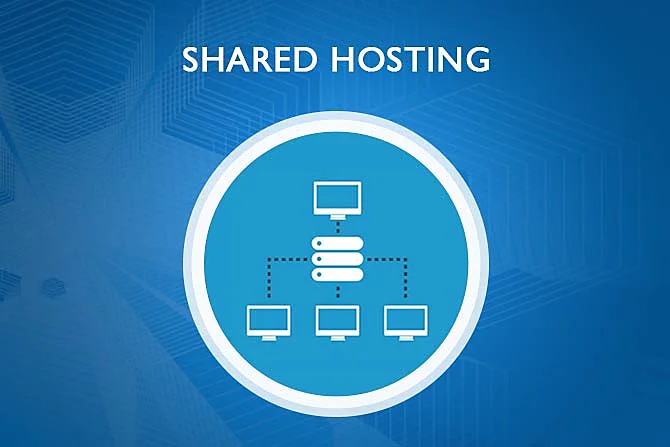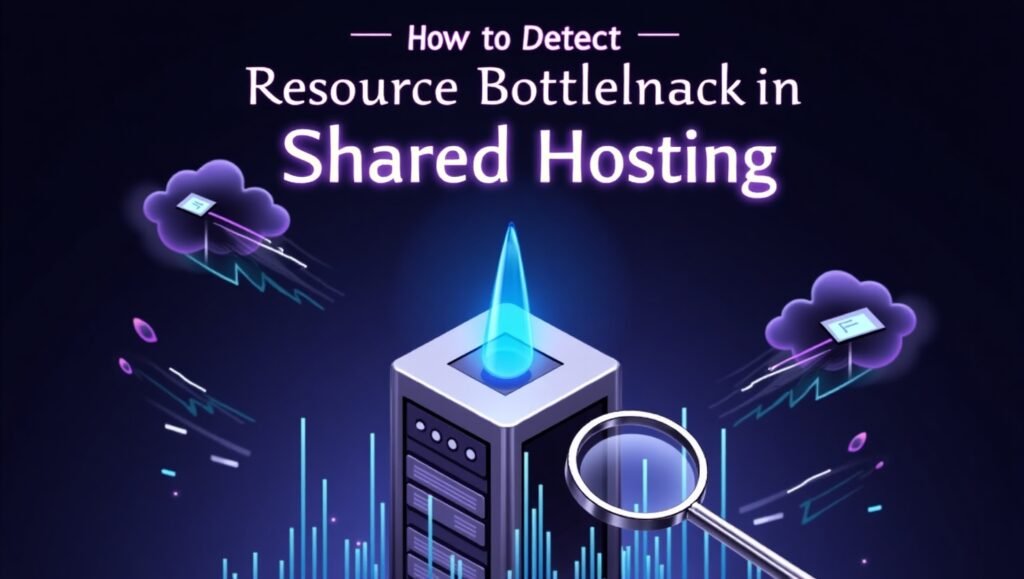In the world of website performance, speed and reliability are critical. For small to mid-sized websites, shared hosting is a cost-effective option. However, with that affordability comes limitations. Shared hosting means you’re sharing server resources (CPU, RAM, disk I/O, bandwidth) with many other users. This setup can often lead to resource bottlenecks, which slow your website down and affect user experience, SEO, and conversion rates.
In this post, you’ll learn how to detect resource bottlenecks in shared hosting, what causes them, and what you can do to resolve or avoid them.
What Is a Resource Bottleneck?
A resource bottleneck occurs when your website demands more server resources than are available, or when your neighbors on the same shared server consume an unfair share of those resources.
This imbalance leads to:
- Slower page load times
- Server timeouts or internal errors
- Increased Time to First Byte (TTFB)
- Poor Core Web Vitals scores
- Frequent “503 Service Unavailable” messages
In shared hosting, you’re particularly vulnerable to bottlenecks because server resources are not dedicated to your site.
What Is Shared Hosting
Shared hosting is a type of web hosting where multiple websites reside on a single physical server and share its resources, such as CPU, memory (RAM), disk space, and bandwidth. It’s a popular choice for small websites, blogs, and startups because it’s affordable, easy to set up, and usually comes with user-friendly management tools like cPanel.

How Shared Hosting Works
In shared hosting, each user gets a portion of the server’s overall resources. Think of it like living in an apartment building: you have your unit, but you share the water, electricity, and parking with others. If one tenant uses too much of any shared utility, everyone else is affected.
Read Also: How to Choose Hosting Based on TTFB (Time to First Byte)
How It Relates to Resource Bottlenecks
Because resources are shared among multiple websites, there are limits on how much one user can use, and when one or more users consume too much, resource bottlenecks occur. Here’s how:
#1. Overuse by Neighboring Sites
If another website on your shared server suddenly gets a traffic spike or runs a resource-intensive script, it can slow down your website, even if your own site’s traffic is low.
#2. Limited Resource Allocation
Each account is allocated a fixed slice of CPU and RAM. If your site needs more (e.g., during traffic surges), it may slow down, display errors, or even get temporarily suspended for “abuse.”
#3. Disk and Bandwidth Contention
Multiple websites accessing files or databases at the same time can cause delays in disk I/O and data transfers, especially during peak hours.
#4. Lack of Isolation
Unlike VPS or dedicated hosting, shared hosting doesn’t isolate accounts completely. Poorly coded or compromised sites on the same server can degrade performance or introduce security risks for your site
Why Detecting Bottlenecks Is Important
Identifying and addressing bottlenecks early helps you:
- Maintain a fast and stable website
- Prevent downtime or service interruptions
- Improve SEO rankings (speed is a ranking factor)
- Ensure better user engagement and lower bounce rates
- Decide when to upgrade hosting or optimize your code
Common Signs of Resource Bottlenecks in Shared Hosting
#1. Slow Load Times Without Traffic Spikes
If your site is sluggish even during off-peak hours, the problem is likely resource contention — you’re competing with other websites for CPU and memory.
#2. High TTFB (Time to First Byte)
A consistently high TTFB indicates server processing delays, often due to overloaded shared environments.
#3. Frequent Downtime or 5xx Errors
“503 Service Unavailable” or “500 Internal Server Error” messages can signal that your host is throttling your usage or struggling with capacity.
#4. Limited Concurrent Visitors
If your site crashes with just a small number of users, your shared server may be imposing strict CPU or RAM caps.
#5. Admin Panel or Dashboard Lag
If your CMS backend (like WordPress) takes ages to load, you might be hitting memory or process limits.
How to Detect Resource Bottlenecks in Shared Hosting

#1. Use Hosting Control Panel Stats
Most shared hosting providers offer metrics via cPanel, Plesk, or proprietary dashboards.
Look for:
- CPU usage history
- RAM consumption
- I/O limits
- Entry processes (simultaneous users)
- Faults or throttling logs
If you frequently hit the upper limits, you’re experiencing a bottleneck.
#2. Check TTFB with Online Tools
Use tools like:
- GTmetrix
- WebPageTest
- Pingdom Tools
These tools show your TTFB and other load metrics. High TTFB (>500ms) can be a strong indicator of backend slowness due to shared hosting limits.
#3. Monitor Performance with Plugins
If you’re on WordPress, install monitoring plugins like:
- Query Monitor
- WP Server Stats
- New Relic (if supported by your host)
They can reveal slow database queries, memory usage, and server response times.
#4. Use Uptime Monitoring Services
Services like UptimeRobot or StatusCake alert you if your site goes down frequently — a red flag for bottlenecks.
#5. Check for Rate Limiting or CPU Throttling
Some hosts silently throttle your site if you exceed usage. Look for telltale signs in logs like:
- Sudden slowdowns
- Email notifications from your host
- “Resource Limit Is Reached” errors
What Causes Bottlenecks in Shared Hosting?
- Noisy Neighbors: Other users on the server hogging CPU, RAM, or disk I/O.
- Traffic Spikes: A sudden surge on your site or another site on the server.
- Heavy Plugins or Scripts: Poorly coded plugins, themes, or scripts using too much CPU or RAM.
- Database Overload: Inefficient queries or too many requests to MySQL.
- Outdated Software: Running outdated PHP versions or CMS platforms that aren’t optimized.
Read Also: Role of IOPS and Disk Throughput in Web Hosting
How to Fix or Mitigate Bottlenecks
#1. Optimize Your Website
- Minimize plugins and external scripts
- Enable caching (page, object, browser)
- Optimize images and reduce file sizes
- Use lightweight themes
- Compress and minify CSS/JS files
#2. Upgrade Your Hosting Plan
If you consistently hit resource limits, consider:
- Moving to a higher-tier shared plan
- Upgrading to VPS hosting for isolated resources
- Switching to cloud hosting or managed WordPress hosting
#3. Implement a CDN
Content Delivery Networks like Cloudflare or BunnyCDN offload traffic from your server and reduce load times.
#4. Use External Services for Resource-Heavy Features
Offload functions like:
- Email sending (use SendGrid, Mailgun)
- Video hosting (use YouTube, Vimeo)
- Search (use Algolia)
#5. Ask Your Host for Logs or Reports
Your provider may give you more detailed usage reports on request. This helps pinpoint what’s maxing out your limits.
FAQs
Q. How do I know if I’ve outgrown shared hosting?
A. If your site experiences frequent slowdowns, exceeds resource limits regularly, or crashes under modest traffic, it’s time to consider VPS or managed hosting.
Q. Can shared hosting ever be fast?
A. Yes, for low-traffic sites that are optimized. However, you’re always limited by what the host allows.
Q. Do all shared hosting plans have the same limits?
A. No. Some premium shared hosting plans offer more generous CPU and RAM allowances. Always check resource caps before purchasing.
Q. Will caching solve bottlenecks?
A. Caching helps reduce resource usage significantly, but it won’t fix server-level issues caused by other users or poor backend performance.
Q. Can I see which other websites are on my shared server?
A. Yes, using tools like YouGetSignal, but this only shows domains, not their traffic or resource impact.
Why This Matters
Understanding and detecting resource bottlenecks in shared hosting is essential for:
- Keeping your site fast and reliable
- Making informed decisions about when to upgrade
- Optimizing your hosting ROI
- Delivering a smooth experience to users
Many site owners unknowingly suffer from bottlenecks, blaming their CMS or plugins, when the real issue is resource contention on the server.
Conclusion
Shared hosting is a great starting point, but it has limits. If you understand how to detect bottlenecks early, you can proactively improve performance, maintain uptime, and plan for future growth. If your site is slow and none of your optimizations seem to help, it may not be your website’s fault — it might be time to move on from shared hosting.
Would you like help assessing your current hosting environment or finding bottleneck-friendly alternatives?
Let me know, and I can guide you!

